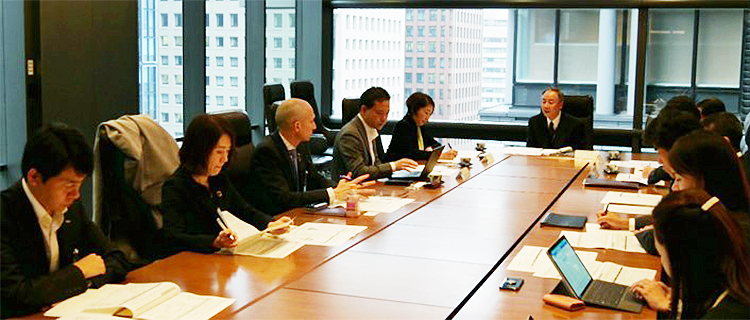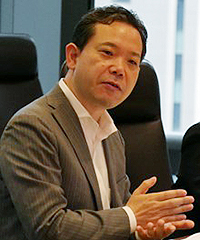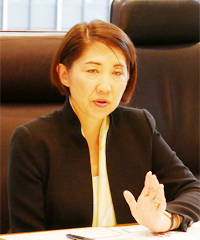

Social impacts required for mega bank group required to solve social issues. (November 27, 2019)
FY2019 Dialogue (2)
Social impacts required for mega bank group required to solve social issues. (November 27, 2019)

In November 2019, SMBC Group held the second dialogue for formulating the “SMBC Group Statement on Sustainability”
As the result of the dialogue held in September 2019, we clearly recognized that in order to formulate the Statement, it is necessary to first determine our future ideal, and then to set specific initiatives and indicators to achieve that ideal.
Therefore, we are required to set long-term plans and KPIs that have “social impacts.”
Our Group took the following two points into consideration:
1.What kind of “social impacts” we had as the result of the initiatives taken through our business activities.
2.Do the “social impacts” that we aim to have reflect what is needed by society?
Through this dialog, we received comments from experts about appropriate factors required by society considering the two points above, in order to set KPIs from the perspective of “social impacts,” not traditional financial KPIs.
Note: Participants’ company names, titles, etc., are those at the time when the dialogue was held.
Experts who participated in the dialogue

Mr. Ken Ito
Executive Director
Social Value Japan

Ms. Miyuki Zeniya
General Manager
Investment Planning Dept. & Responsible Investment Dept.
The Dai-ichi Life
Insurance Company, Limited
Participants from SMBC Group
Sumitomo Mitsui Financial Group, Inc.(SMFG) and other SMBC Group companies
Moderator:Eiichiro Adachi, Counselor, The Japan Research Institute, Limited(JRI)
Q. Along with formulating the “SMBC Group Statement on Sustainability,” SMBC Group is considering specific measures and KPIs. We would like to set KPIs based on the “social impacts” needed by society that we have not considered thus far. Could you give us some advice on this?
- SMFG Suehiro
- Advice we received in the previous dialogue (held on September 5, 2019) to formulate the “SMBC Group Statement on Sustainability,” is that it is necessary to set specific measures.
- To present the impact needed by society in our long-term plan for sustainability, what kind of KPIs are preferable? We would like to receive advice from experts to formulate future plans.
Q. First, we would like to ask Mr. Ito, a specialist of “social impact assessments” about the overview of social impact assessments and the characteristics of individual methods.
- Mr. Ito
- Traditional business assessments only report the output (the results of the measures taken). Taking it one step further, social impact assessments attempt to evaluate social impacts caused by outcome (impacts on society that the output is expected to have). The difficult points about this methodology include that there is a time lag until the achievement of the outcome, and that it is costly.
- The key point is how to measure in concrete terms. As an example, there is a movement to ensure comparability by using different standards such as 169 targets of the SDGs or IRIS standard. This movement is accelerating to ensure mutual compatibility in social impact assessments.
- JRI Adachi
- There are two opinions on impact assessments. One is, “It’s not possible to assess things unless they are quantified,” and the other is, “It’s sufficient if there is something qualitative, like a story.” I would like to ask Mr. Ito about how aware you are of converting data into quantitative measurements.
- Mr. Ito
- Social impact involves both quantitative and qualitative aspects of impact, and the need to convert data into something numerical is very strong. This is because indexing is always required for institutionalization and systematization. And to create a market, quantitative indicators to create a market mechanism are required. As such a movement, the creation of standards has just started.
- SMFG Mikami
- Do quantitative indicators include something like customer satisfaction?
- Mr. Ito
- Yes. There is variety of ways to evaluate customer satisfaction. Quantitative data could be used to complement a qualitative story.
Q. How are impact assessments conducted?
- Ms. Zeniya
- Our company mainly conducts individual corporate investments of unlisted domestic enterprises. Currently, there is no globally established social impact measurement method. Therefore, as an impact assessment for our impact investment, we first choose companies and enterprises that meet the internal criteria as our investment scope, and then judge what kind of impacts they have respectively.
- Although it will be hard to monitor targeted companies if their number increases, this will result in increasing our own knowledge of impact investment, which will allow us to promote our initiatives in the future.
- JRI Adachi
- Regarding impact assessments, should we think simply that evaluation indicators and conversion formulas for quantification are different depending on project? In addition, are industry types divided into ones that are easy to assess and ones that are not?
- Ms. Zeniya
- As there are various areas of measurement with respect to the impact, evaluation indicators and conversion formulas are different. Taking this into consideration, there may be some items in which our company cannot invest at the moment, and therefore we lose them.
- Mr. Ito
- From a standpoint of a researcher in social impact, there are different industry standards for impact assessments such as IRIS. IRIS’s latest version has more than 1,000 indicators and presents recommended indicators according to the type of business.
- It is not necessary to use all of them. Right now around 15,000 companies have signed up as users, so I think comparability may be eventually ensured.
- Among the impact funds, they usually have clear definition on industry focuses, priority policies as well as the targeted social issues such as particular goals of the SDGs. It can be said that among them, the “environment” is a category that is easy to evaluate because it has a vast amount of information and an enormous industrial scale. On the other hand, there is a concern that social impact investments will be concentrated to the areas that are easy to handle, such as the environment.
- JRI Adachi
- Our Group has also put effort into financial education. What do you think of evaluating the area of education, for example?
- Mr. Ito
- Considering education’s social impact on the “personal growth,” I think it is necessary to see a long period of time to realize its outcome. In the United States and the U.K., for example, there are indicators on education based on research conducted for 15 to 20 years, so it helps to conduct social impact assessments. On the other hand, indicators on education in Japan are short-term and the indicators are more on output level, such as changes of test scores. In such a case, there will be a problem of whether or not those indicators correspond to an impact on the “personal growth”.
Q. As we consider the impacts brought about by our Group’s initiatives through businesses, what should we think about “impacts” on society? Please give your opinions about this.
- Mr. Ito
- From the perspective of social impact assessments, the theory is to think using the four-quadrant method. The four quadrants are called “Positive impacts,” “Negative impacts,” “Intended outcomes” and “Unintended outcomes.”
- From the standpoint of PR, PR highlights intended positive outcome. With impact assessments, however, the theory is to also consider the negative and measure both intended and unintended social impacts.
- Negative outcomes are still generally expressed as “risks.” In order to reduce risks, communication with stakeholders are required.
- Furthermore, I think that there is a trickle-down (ripple effect) impact. The trend of inquiries about social impact has been changing over the last two years. Thus far, the departments from which we received inquires used to be mostly CSR departments of companies. Recently, however, inquiries from IR departments are increasing aware of importance of social impact because they recognize the necessity to think about their business risks and impact from the viewpoint of investors.
- Ms. Zeniya
- Our company engages with investee companies by interviewing them every year. Up to three or four years ago, the management had no clear sense of solving social issues related to SDGs through business activities.
- To solve social issues through core businesses, I think that it will be the first step for the management to recognize the necessity and then to reaffirm the answers to the questions of “What is their company’s value in society?” and “What role is their company expected to play by society?”
- Mr. Ito
- As an example, the IFC and the United Nations launched an Impact Management Project in 2018. There are several thousands of funders who support the Project as partners, and a global stream of practicing social impact assessments has been created. In the world of impact assessments, there is also a movement toward integration. Regarding practice, however, the base is still narrow.
- If this movement advances, social impact assessments and social impact investments will soon hit a tipping point(social tipping point).
Q. What kind of social impacts are required for SMBC Group?
- SMFG Takeda
- Social impacts that a pure-play company (project=corporate entity) has through business activities are directly linked to its business itself and are easy to understand. On the other hand, when a financial group like us indirectly supports customers’ business through funding, our business portfolio and resulting social impacts are diverse. What kind of “social impacts” are financial groups, which indirectly have impacts on society, required to have? In addition, what should we set as the outcome to achieve them?
- Ms. Zeniya
- Considering economically why banks are needed, it could probably be said that it is “because they have credit-creating functions.” Credit creation is built upon trust and cannot be built without social trust. I think we have come to a period where we need to reconsider what social trust is based on.
- In the current era, financial institutions are not required to have only functions in the capital market. They need to play a role as comprehensive social infrastructure including not only money but also services as a whole so that people will feel like “if I associate with a bank, it will be beneficial to me and society.” I think this will be the sense of stability and sustainability that financial institutions will be required to provide in the future society.
- Mr. Ito
- The change in consciousness of executives and regular employees has recently become an agenda for discussions on corporate social value. If employees’ increased awareness of sustainability leads to personnel evaluation and corporate culture, I think many potentials for impact business that exist in the company will come to the surface.
- Ms. Zeniya
- Even if the management externally announces that they would like to do something, it will unlikely to actually happen unless that initiative and personnel system are linked.
- It may be difficult to drastically change the personnel system at one time, but it is necessary to change it into a system where employees who practice company’s policies are highly rated.
- With regard to recruiting activities, if there is a major difference between what employees were told before joining the company and the reality after joining the company, it will lead to the early retirement of young employees, which is an issue that must be seriously considered. For financial institutions in particular, their next ten and twenty years depend on whether they can gain superior human resources or not. They cannot hire excellent human resources unless they come to an interview. And if there is a shortage of superior human resources, it will be difficult for them not only to provide and develop good products and services, but also to maintain the current status.
- This applies not only to Japanese people but also globally, and I think that particularly members of Generation Z choose companies with such values.
- SMFG Suehiro
- We brought up this issue partly because our Group tended to lack perspective on employees. We can set goals but we don’t know whether indicators established by the company will resonate in the heart of employees.
- On the contrary, I think that if we announce that “Our Group will reduce CO2 emissions,” it will have the effect of helping many people get to know what our company will do. It is true that there is no answer to what kind of social impacts are needed, but we are going to think about it with a sense of urgency.
- Ms. Zeniya
- Regarding ESG investment evaluation, rating agencies are acquiring ESG evaluation companies at the present time. The concept of ESG has been spreading not only to stock investments but also across finance including bonds and loans at an accelerated pace for about a year.
- While it is forecast that impact investments are yet to come, impact investments will not become popular unless the impact assessment methodology is fully understood.
- SDGs have individual major targets, but we have only ten years left until 2030. There are various issues concerning funds required to solve problems. They include: “How should we apply funds?” “How should we promote the transition of businesses that are considered negative from the perspective of ESG investment?” and “How should we create a market for the provision of funds for the transition?”
- Since these things cannot be done by our company alone, we would like to deal with them in an advanced manner while discussing with the related parties so that we will be able to go in the right direction. I think it is necessary to change actions while monitoring global trends.
Receiving opinions from experts

Takeshi Mikami
Executive Officer
Sumitomo Mitsui Financial Group, Inc.
In formulating the “SMBC Group Statement on Sustainability,” SMBC Group held two dialogues.
We received valuable comments from the following perspectives: the content of the Statement and how to instill it in the company at the first dialogue; and the expectations and roles that our Group is required to fulfill toward achieving a sustainable society through social impacts and the kind of impacts that we can have on society in the second dialogue.
In particular, regarding funds required to solve issues, we received comments of “How we should apply funds” and “How we should promote the transition of businesses that are considered negative from the perspective of ESG investment.” These exactly apply to our Group’s business activities, and I strongly felt that we need to face and consider them through formulation of plans.
With regard to the Sustainability Statement as our basic policy to aim at achieving a sustainable society, we strongly recognize the importance of not only its content but also the measures and indicators that embody it, as well as the importance of firmly instilling this initiative both inside and outside of the company.
All our Group companies will sincerely take on this initiative and accelerate sustainability management.